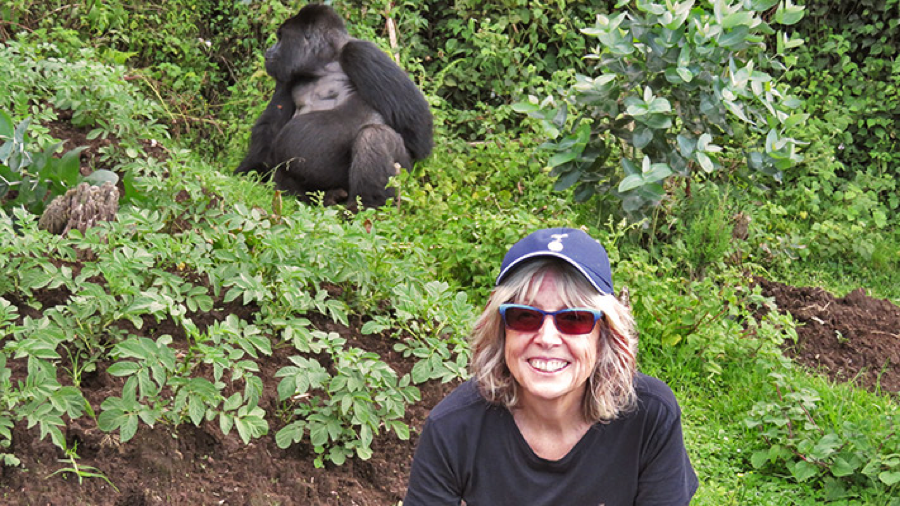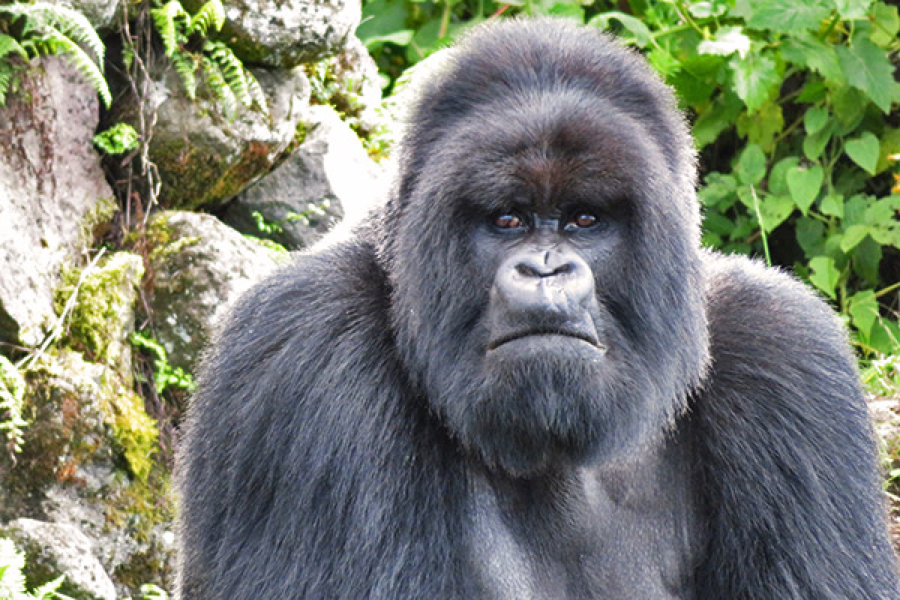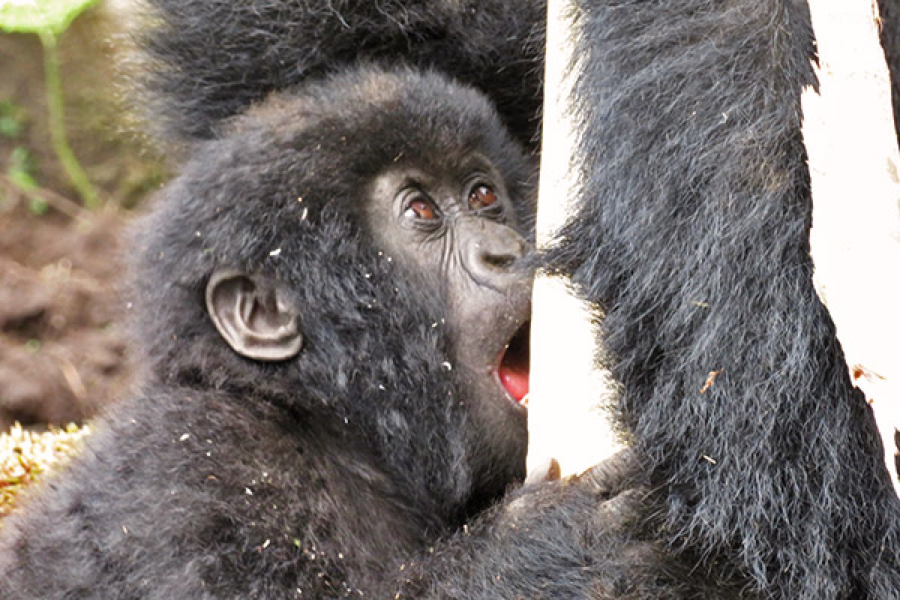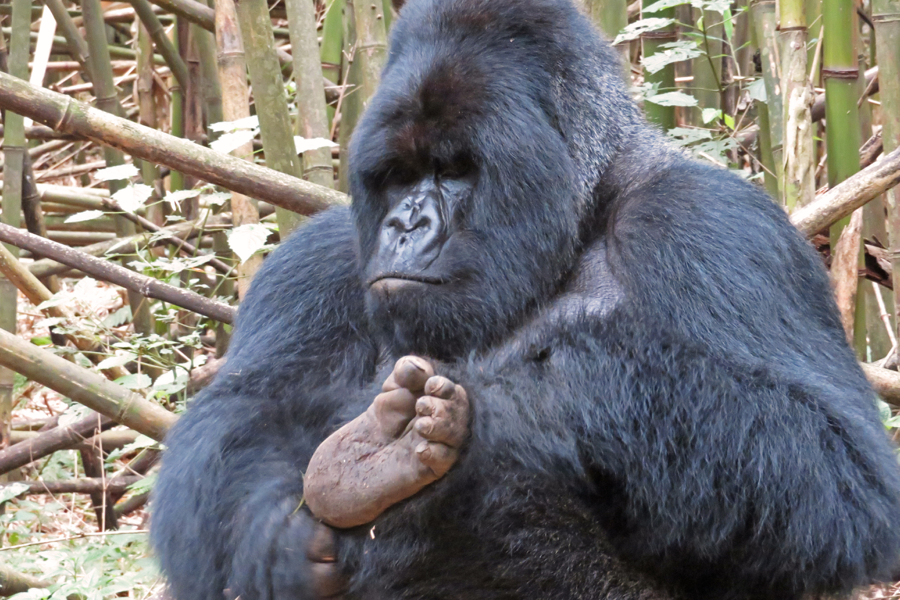Gorilla Trekking in Rwanda
Gorilla Trekking in Rwanda - An Unforgettable Experience

Gorilla trekking in Rwanda is an experience unlike any other. These gentle creatures are breathtaking to witness, and I felt truly privileged to see them in their natural habitat. As an experienced traveler in Africa, I have encountered many of the continent’s wonders, from the thundering Victoria Falls to the extraordinary wildlife—elephants, lions, leopards, and more. Yet, nothing quite prepared me for the magic of coming face to face with Rwanda’s mountain gorillas. There’s something truly awe-inspiring about meeting mountain gorillas in the wild. When they look at you, their deep, knowing eyes create an unspoken connection that feels almost human. These magnificent animals, whose DNA shares 98% similarity with ours, live in tight-knit family groups led by a dominant silverback male. It’s a humbling experience that stays with you long after you’ve left their presence.
Prepping for the Gorilla Trek
Before setting off for our trek, we were introduced to our expert guide, Bosco, who would lead us through the dense forests of Volcanoes National Park to meet the Hirwa gorilla clan. The Hirwa family is known for its size, having grown to 20 members, including a rare set of twins. These family groups are essential to the survival of the mountain gorillas. The silverback leads the group, overseeing the safety and cohesion of the family. Females, including mothers and young, make up the rest of the clan. Juveniles are often the most playful, engaging in games and mimicking adult behaviors, while infants rely heavily on their mothers for care and protection.

Bosco introduced us to the “Hirwa” gorilla clan, the family we would be meeting. The family is so named because “Hirwa” means lucky, which refers to the family’s good fortune: they have grown to a clan of 20 members, including a pair of juvenile twins—a rare occurrence in the wild.
We were also given basic rules for how to approach the family: avoid eye contact, stay alert, be quiet, disable flash on our cameras and keep our distance from the family. Bosco emphasized that our goal, beyond observing this amazing species, was to interrupt the Hirwa family as little as possible.
Meeting the Gorillas
It didn’t take long for us make contact with the gorillas. We hiked for about 30 minutes before Bosco told us that the clan was just ahead, outside a farmer’s field. There was a palpable excitement in the air as I, and others in our group, readied our cameras in anticipation of what we were about to see. As we reached the top of the field, we caught our first glimpse of the clan: they were busily munching on bamboo trees.
The duration of their lunch was clear thanks to the trail of gnawed bamboo trees. The Hirwa family included a silverback, adult females and a few babies. The adorable babies were on full display: playing with mom, frolicking in the bushes and even beating their chests in a lovely impression of their silverback father. One youngster tried determinedly to feed on a thick bamboo stalk by himself, but the tree was just a little too thick!

The size of the adult members of the Hirwa family astonished me. Male silverbacks, the largest members in a family, can weigh up to 480 pounds and the silverback of the Hirwa family was massive! As the other members of the family were busy eating and playing, he mostly sat alone in the background, quietly watching over his family. At one point, while we were watching some of the other gorillas, the silverback approached me — it appeared that I was between him and where he wanted to go. I looked to Bosco who told me to stay calm and let the large silverback walk by, and that’s exactly what he did: the silverback brushed by my leg on his way to munch on some bamboo shoots.

A Commitment to Conservation
Dian Fossey, author of Gorillas in the Mist and the famous mountain gorilla researcher, once remarked, “when you realize the value of all life, you dwell less on what is past and concentrate on the preservation of the future.” I could not have said it better myself! My experience with the gorillas reinforced my feelings that conserving these creatures for future generations is a crucial mission, one that benefits us all.
Rwanda’s dedication to preserving mountain gorillas and their habitats is crucial to their survival. Thanks to sustained conservation efforts, the country’s mountain gorilla population continues to grow. To protect these endangered animals, the government strictly regulates tourism. Only 96 permits are issued daily for treks in Volcanoes National Park, with each of the 12 habituated gorilla groups visited by a maximum of eight tourists. Revenue from these limited permits directly funds conservation and research initiatives. Beyond protecting the gorillas, Rwanda’s conservation model also benefits local communities. Ten percent of permit revenue is allocated to building schools, health centers, and roads, while a compensation fund reimburses farmers for crop damage caused by gorillas, fostering peaceful coexistence. Gorilla trekking also provides employment for many locals, including rangers, trackers, porters, drivers, and staff at lodges, ensuring that conservation efforts support both wildlife and people.
The experience of trekking with mountain gorillas is not only a chance to witness one of nature’s most majestic creatures, but it also plays a part in supporting their future. If you are considering a gorilla trekking adventure, the experience is sure to be transformative, offering a deeper understanding of these incredible animals and their unique family structures.
For those eager to embark on this unforgettable adventure, our Discover Rwanda itinerary offers the chance to trek with mountain gorillas, along with a Big 5 safari in Akagera National Park. You can also visit Kigali, the vibrant capital of Rwanda, where you’ll learn about the country’s inspiring journey and how you can contribute to ongoing conservation efforts, all while enjoying the stunning beauty of Rwanda’s landscapes.
5 Fascinating Facts About Zebras and Where to See Them on Safari
One of the most iconic sights on safari is the striking black-and-white stripes of a zebra grazing on the open plains. Whether standing in small family groups or moving in massive herds, these fascinating animals are a delight to observe in the wild. Most safari destinations in Africa have plenty of zebras, making them a common but always captivating sight.
Zebras belong to the horse family and are native to Africa, with three different species found across the continent: the plains zebra, Grevy’s zebra, and mountain zebra. The plains zebra is the most common, roaming the grasslands and woodlands of eastern and southern Africa. Grevy’s zebras inhabit the dry, semi-desert regions of Kenya and Ethiopia, while the mountain zebra is adapted to the rugged terrain of Namibia, Angola, and South Africa.
-
Every Zebra Has a Unique Stripe Pattern – and It Helps with Camouflage
Just like human fingerprints, no two zebras have the same stripe pattern. Scientists believe this helps with individual recognition within their herds. Their stripes also serve as a form of camouflage—while a single zebra may stand out, a moving herd creates an optical illusion that confuses predators. The bold contrast makes it harder for lions and other predators to single out an individual, increasing their chances of survival.
-
Zebras Are Highly Social Animals
Zebras live in family groups called harems, consisting of a dominant stallion, several mares, and their young. These groups often come together to form larger herds for safety. Their strong social bonds help protect them from predators, and they even communicate using sounds, facial expressions, and ear movements.
-
They Can Sleep Standing Up
Like their relatives, horses, zebras can sleep while standing, locking their knees to rest without collapsing. This ability helps them stay alert to danger, as they can quickly flee from predators if needed. However, zebras still lie down for deeper sleep when they feel safe in a group.
-
Zebras Are Tougher Than They Look
While they may seem peaceful, zebras are strong and can be aggressive when threatened. Stallions defend their harems using powerful kicks and sharp bites. When facing predators like lions or hyenas, zebras will stand their ground in a defensive semi-circle and even try to protect injured members of their group.
-
Zebras Embark on Epic Migrations
Zebras are found across Africa, but some undertake remarkable seasonal migrations. In East Africa, they play a key role in the Great Migration, traveling alongside wildebeest and gazelles across the Serengeti and Maasai Mara in search of fresh grazing. In Botswana, two zebra migrations take place. The Chobe-Nxai Pan migration, one of Africa's longest mammal migrations, spans over 1,000 km, with tens of thousands of zebras moving between the Chobe River and Nxai Pan. The Okavango-Makgadikgadi zebra migration, though smaller in scale, is equally impressive. Zebras are drawn to the Okavango Delta’s floodwaters during the dry season, and when the rains arrive in the Makgadikgadi area, they head there to find lush, nutritious grasses.
Where to See Zebras
Zebras can be found in nearly every major safari destination in Africa, from Kenya and Tanzania to Botswana, Namibia, and South Africa. If you want to witness large herds on the move, the Serengeti is one of the best places to go. Our Tanzania Explorer itinerary covers the country’s most iconic national parks on a small-group, locally hosted safari. With three nights in the Serengeti, you’ll have plenty of opportunities to see zebras alongside other incredible wildlife, from lions and elephants to wildebeest and giraffes.
To see the unique Grevy’s zebra, found only north of the equator, our Kenya Wildlife Safari takes you to the Samburu region, where you’ll encounter the Samburu Five—Grevy’s zebra, reticulated giraffe, Somali ostrich, Beisa oryx, and gerenuk. This immersive itinerary also explores Lake Nakuru and the iconic Maasai Mara. Travel in a small group with a local guide, with everything covered, including international airfare from JFK.
My First Visit to South Africa
My first trip to South Africa was unforgettable, offering a rich blend of nature, history, culture, food, and wine. Traveling with a group of fellow travel professionals made it even more special, as we shared incredible moments — from exploring the many corners of Cape Town to enjoying an incredible safari in a private Kruger reserve. While it wasn’t my first African safari, it was everyone’s first visit to South Africa — making the experience even more exciting and meaningful.
Exploring Cape Town
Our journey began in Cape Town, a city rich in culture, natural beauty, and history. We stayed at the Cape Cadogan Hotel, an elegant boutique hotel on the corner of Kloof Street, one of Cape Town's most vibrant and stylish neighborhoods. The area is teeming with trendy restaurants, bars, and cafés—perfect for exploring the city’s culinary scene and nightlife. The hotel served an à la carte breakfast each morning, which we all looked forward to, and our dinner at Cape Cadogan was one of the best meals of the trip. The creative dishes were designed for sharing and were incredibly tasty—who knew smoked cabbage could taste so good?
We visited the famous Victoria & Alfred Waterfront, a lively spot with stunning views of Table Mountain. We strolled along the waterfront, indulged in fine dining, and shopped for souvenirs while soaking in the picturesque setting.
We also took a boat tour to Robben Island, where Nelson Mandela was imprisoned for 18 years. The tour was led by a former prisoner, which made the experience even more personal and unforgettable. He shared powerful stories about his time on the island and the fight for equality and democracy in South Africa. It was a humbling experience that deepened our understanding of the country’s history and resilience.
That evening, we dined at GOLD Restaurant, which offered a culinary safari featuring a 14-course tasting menu inspired by different African cuisines. The meal was accompanied by cultural performances, and everyone at the restaurant participated in a lively drumming session.
Cape Peninsula and Table Mountain
Our Cape Peninsula tour was a spectacular highlight. The dramatic cliffs and sparkling blue waters created a breathtaking coastline. We visited the Cape of Good Hope, a stunning rock outcrop often mistaken for the southernmost point of South Africa. Just a few minutes away is Cape Point with more incredible views from the lighthouse and lookout points. After lunch at Simon's Town, we visited Boulders Beach to see the colony of African penguins. Watching these adorable creatures waddling along the sand brought so much joy to our entire group.
Later that day, we took advantage of the clear afternoon skies to visit Table Mountain. It had been foggy in the morning, but by the afternoon, the weather was perfect—crystal clear with no wind. The views from the top were absolutely breathtaking, offering panoramic vistas of Cape Town, the ocean, and the surrounding mountains. The sunset cast a golden glow over the city, making the experience even more magical.
Winelands Adventure
Another day of adventure took us to the breathtaking Cape Winelands, about 90 minutes from Cape Town. The region’s rolling vineyards and charming towns created the perfect setting for relaxation and indulgence. We explored Franschhoek, sampled wines at two popular wineries, and enjoyed a delicious al fresco lunch. At Rickety Bridge Winery, we even tried our hand at wine blending—the results were mixed, but everybody had a good time.
Arriving at Kruger Private Reserve
After exploring Cape Town, we flew to Skukuza Airport in the Greater Kruger area, where our guides from Tinga Lodge met us. Located in the Lion Sands Private Game Reserve, Tinga is just a few minutes from the airport and perfectly positioned on the banks of the Sabie River. From the lodge, we enjoyed stunning views of elephants, hippos, and other wildlife gathering to drink or cool off. Being in a private reserve within Kruger allowed us to experience intimate safari drives without the crowds of the national park. We also enjoyed extended evening game drives with picturesque sundowners and had the opportunity to explore off-road for closer wildlife encounters.
The accommodations were spacious and elegantly designed, with each room featuring a private plunge pool overlooking the river—a perfect spot to unwind after a game drive. The dining was exceptional, with all meals and drinks included. The complimentary laundry service was a thoughtful touch, especially after a few warm days on safari.
Safari Adventure in Kruger
Our days began early with a quick coffee and pastries before heading out for a game drive around 5:30 AM. The African sunrise over the savannah was magical. We were led by Dre, our expert guide, and Wanted, our tracker, who were always on the lookout for wildlife. Their skill and knowledge made every drive exciting and full of surprises.
We saw lions, giraffes, leopards, elephants, baboons, kudus, impalas, zebras, and even an elusive leopard. The chance to see these majestic creatures up close in their natural habitat was truly amazing. Along the way, we stopped for a coffee break in the bush and to stretch our legs.
After the morning drive, we returned to the lodge for a hearty breakfast and some downtime. The lodge’s pool and spa were the perfect place to unwind between drives. The spa treatments left us feeling rejuvenated, and we enjoyed the outdoor spaces, watching for wildlife from our lounge chairs.
In the afternoon, we set off for another game drive, ending with a sundowner—watching the sun dip below the horizon while sipping on cocktails. One evening, we had an exhilarating encounter with a white rhino by the river. As the rhino approached, we had to back away for safety, but our luck held—we saw the same rhino the next day, walking right by the road. It was an unforgettable moment.
A Perfect First Trip to Africa
South Africa is a land of striking contrasts, where vibrant cities meet breathtaking wilderness, and every moment is filled with excitement and discovery. It's no surprise that it's the top choice for first-time safari-goers, offering a mix of incredible experiences in some of the most luxurious settings. Our South African adventure was a dream come true for everyone in our group, leaving us with memories we'll cherish forever.
Ready for your first South African adventure? Browse our selection of suggested South Africa Itineraries for inspiration. Reach out to us to create your dream journey.
- « first
- ‹ previous
- 1
- 2
- 3
- 4






